Spitzer's Cold Look at Space
By Michael Werner
To get a clear view of infrared emissions from celestial objects, the Spitzer Space Telescope has been cryogenically cooled—and what sights it has seen
To get a clear view of infrared emissions from celestial objects, the Spitzer Space Telescope has been cryogenically cooled—and what sights it has seen

DOI: 10.1511/2009.81.458
In astrophysical observations, more is more—imaging across multiple wavelengths leads to richer information. One electromagnetic band in which most celestial bodies radiate is the infrared: Objects ranging in location from the chilly fringes of our Solar System to the dust-enshrouded nuclei of distant galaxies radiate entirely or predominantly in this band. Thus, astrophysicists require good visualization of these wavelengths.
The problem, however, is that Earth is a very hostile environment for infrared exploration of space, as the atmosphere also emits in the infrared spectrum and additionally absorbs much of the incoming signal. Even heat produced by a telescope itself can degrade its own clarity.
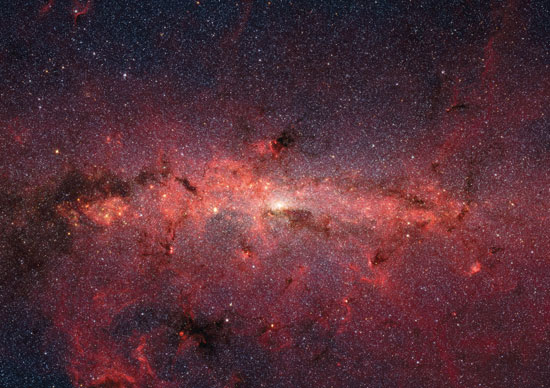
Image courtesy of NASA/JPL-Caltech/S. Stolovy [Spitzer Science Center/Caltech].
Starting at the end of the 1950s, a number of pioneering groups confronted this challenge and carried out increasingly exciting infrared investigations from ground-based, airborne and balloon-borne observatories. This work continues in parallel with space-based exploration; infrared capabilities form an integral component of current and planned ground-based telescopes with apertures of 10 to 30 meters in diameter.
But the best solution is to send into space a telescope that’s cooled by liquid helium to temperatures just a few degrees above absolute zero. NASA’s Space Infrared Telescope Facility (SIRTF) was proposed in the early 1970s and finally launched in August 2003. It was renamed the Spitzer Space Telescope in honor of the late Lyman Spitzer, Jr., an astrophysicist who was one of the first to propose the idea of placing a large telescope in space, and was also the driving force behind the Hubble Space Telescope. Therefore it’s very appropriate that Spitzer is a member of NASA’s multi-spectral family of Great Observatories satellites, which also includes Hubble, the Chandra X-ray Observatory and the recently launched Fermi Gamma-ray Space Telescope.
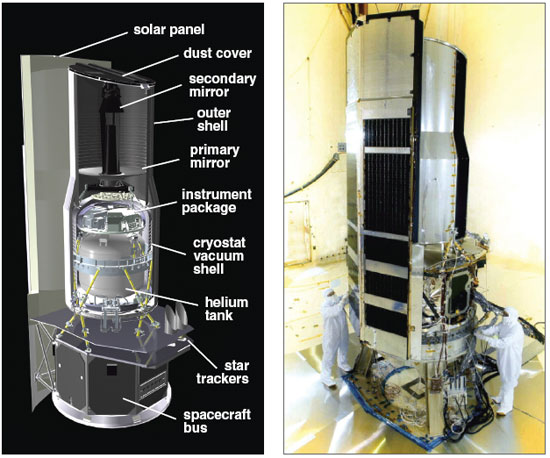
Illustration at left is adapted from image courtesy of Ball Aerospace; image at right courtesy of the Spitzer Science Center.
The Spitzer Space Telescope, about 4.5 meters tall and 2 meters in diameter, weighed 861 kilograms at launch. It is in orbit around the Sun, allowing its solar panels to always face their energy source while simultaneously shielding the craft from the Sun’s heat. Behind its solar array, a passive radiative-cooling system of reflective and emitting shells and shields allows the telescope’s outer shell to cool to about 34 kelvins. Onboard, helium vapor does the rest of the job of getting the payload down to about 5 kelvins or less, just slightly above absolute zero.
Spitzer is not the first cryogenically cooled infrared observatory in space, but it goes beyond its two successful and pioneering predecessors, the Infrared Astronomical Satellite (IRAS) that lasted for 10 months in 1983, and the Infrared Space Observatory (ISO) that operated from 1995 to 1998. For one thing, Spitzer uses a new generation of infrared detectors comprised of large arrays of sensors, whereas the previous missions used single detectors or small arrays. The quality of Spitzer’s arrays and its slightly larger aperture give it typically about 10 to 100 times the sensitivity of these earlier observatories. In addition, Spitzer’s arrays have 10 to 100 times more pixels than previously available on a cryogenic telescope in space.
Since its launch, Spitzer has provided the scientific community the most powerful tool yet available for astronomical explorations at wavelengths between 3.6 and 160 micrometers, known as mid-to-far infrared. The telescope uses an 85-centimeter primary mirror to direct infrared radiation to three main instruments: a short-wavelength infrared array camera, a long-wavelength multiband imaging photometer (which, like the camera, measures the intensity and spatial distrubution of radiation) and an infrared spectrograph (which can identify the type and amount of chemical compounds present by the specific spectrum they emit).
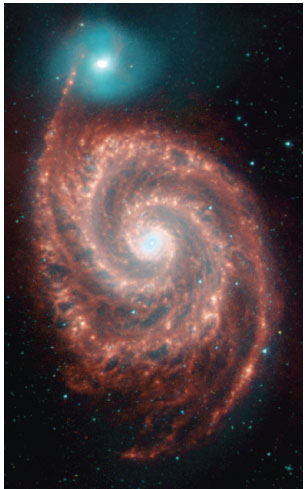
Image courtesy of NASA/JPL-Caltech/R. Kennicutt [University of Arizona]/DSS.
A cooled telescope reduces the background infrared brightness of the sky by about six orders of magnitude; this is about the factor by which the sky brightness at visible wavelengths drops from high noon on a sunny day to midnight on a moonless night. The effects of the background reduction are so powerful that Spitzer, with its relatively small mirror, is more sensitive for many infrared observations than even the largest ground-based telescopes.
Although infrared wavelengths are invisible to human eyes and instead we perceive them as heat, it is ironically the colder objects, too frigid and with too little energy to glow visibly, that emit primarily in the infrared. And happily, infrared signals can be seen through much of the dust that enshrouds objects of interest, such as stellar nurseries and very energetic galactic nuclei. Spitzer has made remarkable progress in studying such objects, and also has been incredibly successful at directly measuring light from exoplanets (planets orbiting other stars) for the first time.
The first phase of Spitzer’s rich scientific life came to an end as the last milligrams of its onboard liquid helium evaporated into space on May 15, 2009—several years beyond the contractually required end of the cryogenic mission, as the onboard cooling system’s efficiency exceeded expectation. But there are still great prospects for the telescope’s rebirth as the Warm Spitzer mission; it may now be limited by heat, but it still has powerful capabilities for continuing exploration of the universe.
With 40,000 hours of observations already under its belt, resulting so far in well over 1,500 published research papers from astronomy teams all over the world, Spitzer’s scientific returns already go far beyond what can be discussed in a single article. But even just a few examples of Spitzer’s most significant results are illustrative of the range of science that the telescope has produced.
Within a few thousand light-years of the Sun, in our corner of the Milky Way galaxy, new stars and planetary systems are forming from the gravitational collapse of dense interstellar clouds. Much of the formation and early evolution of stars occurs at temperatures and densities that are particularly well suited to study in the infrared. Spitzer has proved to be a very powerful instrument both for studying large-scale patterns of star formation and for detailed studies of individual nascent stars.
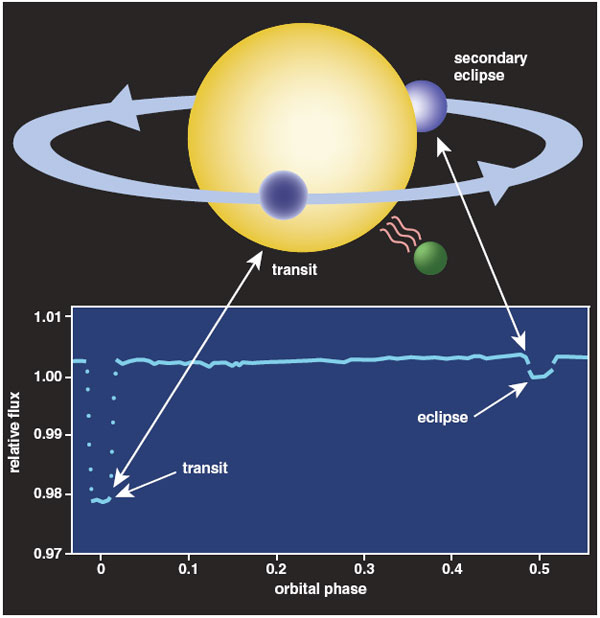
Illustration adapted from image courtesy of the author; graph adapted from H. A. Knutson et al, Nature 447:183–186.
In addition, Spitzer has reinforced our previous understanding that the early star will be embedded in a circumstellar disk that develops as a result of the conservation of angular momentum in the collapsing cloud. The material in the disk can evolve into a planetary system, and the recent discovery of planets around literally hundreds of nearby, solar-type stars indicates that this occurs very frequently. The dense, planet-forming (or protoplanetary) disk is an ideal target for infrared studies as it is heated by the star and reradiates in the infrared. The protoplanetary disk dissipates as planets form and the star evolves, leaving behind a tenuous, residual debris disk consisting of dust particles that are generated and regenerated by evaporation or by collisions of asteroidal or cometary objects within the planetary system. Spitzer can easily study these debris disks—which are useful indicators of planetary-system evolution—around numerous solar-type stars because their large surface area makes the disks brighter in the infrared than are the stars themselves.
At the other end of the process of planetary production, Spitzer has directly measured the light from fully formed planets circling other stars. Most known exoplanets have been discovered by observing their effects on the star they orbit. Most often, this is done using a technique that exploits the small variations in the star’s radial velocity, as seen from the telescope’s position, in response to the gravitational pull of the orbiting planet. With one or two startling exceptions, however, the light from an exoplanet cannot currently be spatially separated from that of its parent star; the star is too bright and the planet too close.
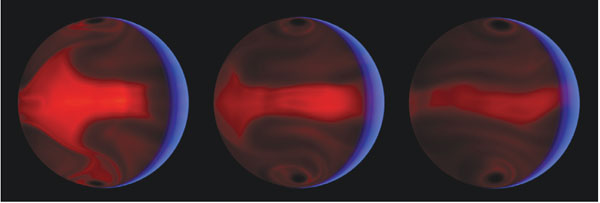
Adapted from image courtesy of NASA/JPL-Caltech/J. Langton [UC Santa Cruz].
The exoplanets found by the radial-velocity technique tend to be large planets close to the stars, as these produce the largest signal. Exoplanets of this type have been dubbed “hot Jupiters” because they are of a similar mass to our Jovian neighbor and are greatly heated from being so near their star. In fact, the first exoplanet discovered, 51 Pegasus b, announced in 1995, was a Jupiter-mass planet in an orbit a fraction of the size of Mercury’s; this setup was so different from our solar system and from all expectations that it unleashed a flood of theoretical and modeling papers that has continued to grow as other surprising exoplanet systems are discovered.
Now we know of more than 350 exoplanets orbiting more than 200 stars near the Sun. These objects are in systems containing up to five planets, and the smallest exoplanets that can now be detected are less than five times the Earth’s mass. Even as further discoveries pour in, it is important to start characterizing these exoplanets, to understand both the universal features of planetary systems and any idiosyncrasies that may have been at play in the formation of our own solar system. Although ground-based and Hubble Space Telescope studies have also been important, Spitzer has been the astronomical community’s most powerful tool for characterizing exoplanets. The results continue to show that the formation and evolution of planetary systems is a much richer topic than we had thought.
A large exoplanet close to its star—and therefore heated to, say, 1,000 kelvins or more—can be bright enough in the infrared for Spitzer to detect if it lies within about 200 light-years of the Sun. Spitzer has detected these hot Jupiters in numerous cases by temporally, rather than spatially, separating the light of the star from that of the planet. This technique is applied most simply to exoplanets in an orbit that lies edge-on as seen from Earth. When the planet passes in front of the star (or transits), there is a drop in the infrared signal from the star-planet system due to the physical blockage of the stellar disk, and this phenomenon permits an estimate of the size of the planet.
When the planet passes behind the star (or goes into secondary eclipse), there is again a drop in the infrared signal, but this time it’s because the planet’s contribution is no longer present. The size of this drop relative to the signal from the star measures the amount of infrared radiation from the planet. These observations, which require measurements with a precision of better than 0.1 percent over timescales of hours, are possible because of Spiter’s high sensitivity, along with the high stability and long, continuous viewing periods characteristic of Spitzer’s solar orbit.
The observations are particularly valuable when carried out at multiple wavelengths simultaneously using Spitzer’s spectrograph. Because hot Jupiters are rich in gas, different wavelengths arise from different levels in the atmosphere or different chemical constituents. Spitzer data have allowed the determination of planetary temperatures and of constraints on chemical composition (including the identification of water vapor), atmospheric structure and atmospheric dynamics. Spitzer has already characterized more planets (at least 19 in total) orbiting other stars than exist in our solar system; the planets characterized lie between about 50 and 200 light-years from Earth.
One study compared Spitzer measurements at five wavelengths of the exoplanet HD 189733b with predictions for radiation from a gaseous planet of solar composition at the observed temperature of the planet. The results indicate that HD 189733b does not have a high-altitude temperature inversion as has been inferred for other hot Jupiters, so there must be at least two different classes of atmospheres for this group of exoplanets. The key measurement of temperature inversion will be carried out for numerous other exoplanets during the upcoming Warm Spitzer mission, so we are likely in for more surprises.
Spitzer’s solar orbit permits extended, continuous observations over a complete 40-hour planetary orbit, not just for a few hours around transit or eclipse. Because the exoplanet is tidally locked to its star, the same hemisphere faces the star continually, just as tidal locking keeps one hemisphere of the Moon perpetually facing the Earth. In its edge-on orbit, the illuminated hemisphere comes gradually into view as the planet moves from transit to eclipse.
This led to the first mapping of the day-to-night temperature variation in an extrasolar planet, where days reached around 1,210 kelvins and night dipped to around 970 kelvins. In addition, the fact that the hottest area on the exoplanet is not closest to its encircled star means that there is substantial heat transport in this exoplanet’s atmosphere. It is estimated that winds in excess of 5,000 kilometers per hour are required in the upper atmosphere of the planet to account for the observed redistribution of the stellar heat.
Not all exoplanets are tidally locked in circular orbits, and perhaps the most extraordinary Spitzer result to date in the study of atmospheric structure and dynamics comes from an observation of a “Big Swing.” A planet in a highly elliptical orbit swooped by its star in such an orientation that Spitzer could monitor the temperature response of the planetary atmosphere to the resultant heat impulse. Fortuitously, the geometry was just right for the observations to include a secondary eclipse as well. The temperature of the planet’s atmosphere increased from 800 to 1,500 kelvins in just a few hours, suggesting that the stellar-heating energy is deposited high in the planet’s atmosphere, which gives clues about its structure.
In these early days of exoplanet characterization, one can but marvel at the variety of behaviors exhibited by the planets that have been studied to date. Recall that the results were all obtained without spatially isolating or imaging the exoplanet. Looking ahead, we can anticipate that newly launched and planned instruments will greatly extend these results, leading up to our first direct images of Earth-like exoplanets sometime in the next 20-to-30 years.
Spitzer’s initial studies of protoplanetary or potentially planet-forming disks concentrated on broadband measurements aimed at tracing, at least statistically, the evolution of the disks over time. These results showed, for example, that the extremely dense and dusty phase of the disks’ lifetime around solar-type stars lasts only a few million years, consistent with estimates of the time required to form gas-giant planets such as Jupiter and Saturn. At the end of this time, many of the small dust particles that were present in the disk as it formed would have coalesced into larger particles, dramatically reducing the dust’s overall surface area and hence its infrared radiation. The formation of rocky planets such as Mars and Earth is thought to proceed over a few tens of millions of years by further coalescence and coagulation of the dust particles.
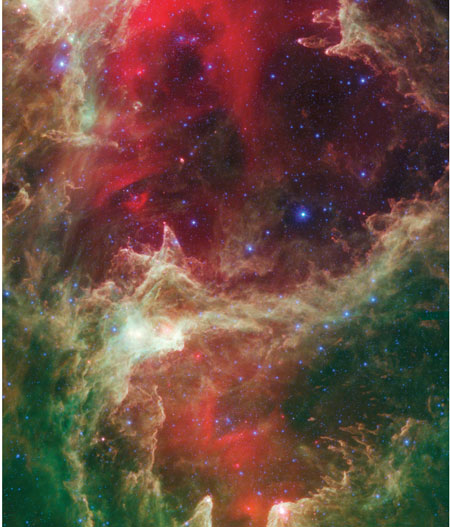
Image courtesy of NASA/JPL-Caltech/L. Allen and X. Koenig [Harvard-Smithsonian CfA].
More recently, research emphasis has shifted towards spectroscopic studies of both the dust and the gaseous component of the disks, as a means of assaying the composition and physical condition of material in exoplanetary systems. Observations of disks in the active planet-forming stages have revealed a rich complex of gas-phase organic molecules, including water, carbon dioxide and carbon monoxide—precursors of the complex organic chemistry that took place on Earth, which eventually led to the formation of life. These observations are unique to the infrared because the principal bands in which such molecules vibrate and produce their spectra fall in this region, and they all are easily excited to do so at the temperature of the protoplanetary material.
Now that spectra of this type are available for literally dozens of disks, it is possible to look for significant variations of the abundance pattern and compare it with other properties of the disk and the central star. One such trend with interesting implications has been the demonstration that the nitrogen-bearing compound hydrogen cyanide (HCN) is less abundant than expected in the gaseous material around forming stars of low mass (having less than half the mass of the Sun) than in more massive solar-type stars. It is thought that the absence of HCN reflects the photochemistry in the planet-forming disk rather than an anomaly in the material from which the star is forming. A possible implication of this measurement is that planetary systems forming around stars in this mass range might be relatively nitrogen-poor. As nitrogen is a major player in biological molecules on Earth, this could suggest that a different set of processes would govern development of life on planets orbiting lower-mass stars than were in play in the terrestrial environment.
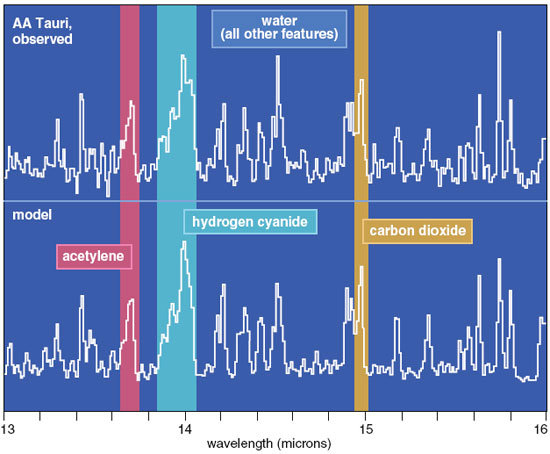
Adapted from image courtesy of NASA/JPL-Caltech/J. Carr [Naval Research Laboratory].
Spectroscopy of the dust, in addition to the gas, associated with protoplanetary disks and exoplanetary systems also has been productive. In general these spectra show smooth, continuous emission, punctuated by broad emission and absorption features due to ices or silicate minerals. The implied composition of the dust particles agrees with that of dust spread diffusely through the interstellar medium, but the physical state of the material can vary dramatically. In particular, the silicate material in the interstellar medium appears, based on its spectral characteristics, to be amorphous in form, whereas that associated with planet-forming and debris disks often shows the sharper emission features of crystalline silicates.
On this topic, Spitzer also took advantage of a unique opportunity to study cometary material in our Solar System by obtaining spectra of the aftermath of the 2005 Deep Impact planned collision with the comet Tempel 1, which liberated a cloud of dust and gas from the subsurface layers of the nucleus that persisted for some 40 hours. A main constituent of the dust, as has been seen in other comets in our Solar System, were again small particles of crystalline silicates, very similar to those from exoplanetary material.
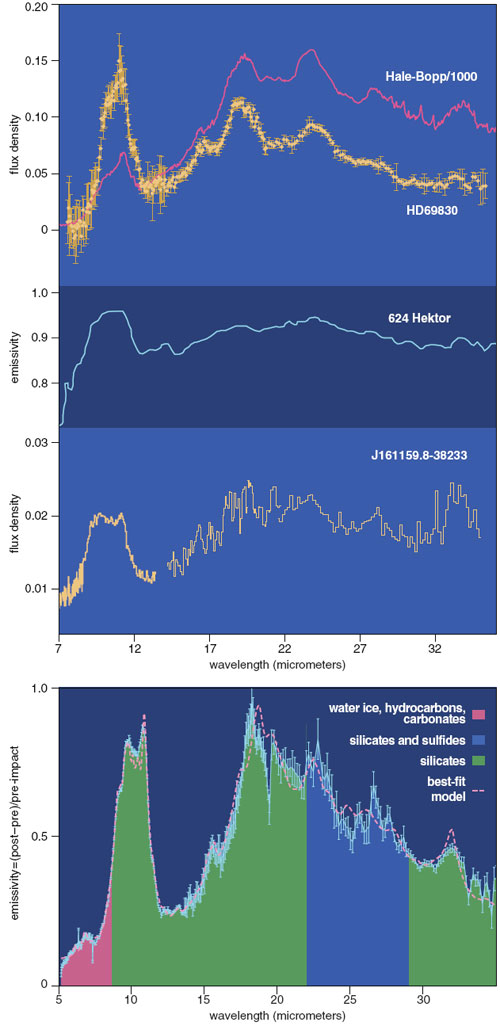
Adapted from graphs courtesy of James Jackson of the Jet Propulsion Laboratory.
Such a result reveals a major puzzle: How do the amorphous materials, which dominate silicates in the interstellar matter from which the star and planetary system formed, convert to the crystalline form that is dominant in planetary systems? It is understood that this requires the amorphous material to be annealed, that is, to be subjected to temperatures greater than 1,000 kelvins, at which the individual molecules in the mineral are free to reorient and reorganize from the amorphous into the crystalline state.
A recently reported Spitzer result gives us our first real insight into the annealing process while also exemplifying the serendipity of scientific undertakings. In this case, a known, young, variable star that had previously been observed by Spitzer brightened by a factor of about 100; this giant flare lasted for several months, after which the star relaxed towards its pre-outburst brightness. An alert group of astronomers noted this phenomenon and were able to observe the star again several months after the initial brightening, but while it was still much brighter than usual.
Remarkably, there was a pronounced change in the character of the silicate emissions between the two observations. In particular, before the outburst the silicate material showed emission characteristic of amorphous material, whereas afterward the emission was crystalline in nature. It appears that the outburst heated the dust at the surface of the protoplanetary disk to above 1,000 kelvins, converting the amorphous material to crystalline form and changing the appearance of the silicate emission. Because such flaring activity is known to occur frequently during the evolution of stars with protostellar disks, it is possible that the large-scale amorphous-to-crystalline conversion results from an accumulation of such flaring events over the 1 million years or so during which the disk is dense and the first stages of planetary-system formation are occurring.
Thus Spitzer contributes to very exciting new research comparing the properties inferred for exoplanetary systems with those of our own Solar System. This activity brings the wealth of detailed understanding we have of our own Solar System to bear on understanding the properties of exoplanetary systems. It also gives us a broader view of solar-system formation and evolution than we can easily extract from the limited spatial and temporal perspective that we have on our home planetary system. This important new scientific endeavor is often referred to as “comparative exoplanetology.”
Spitzer is particularly well suited to carrying out surveys of expansive areas that can cover one percent or more of the sky. The large angular coverage of Spitzer’s arrays and their high sensitivity, along with the maneuverability of the spacecraft, make it possible to explore regions of the sky as large as the constellation Orion to unprecedented sensitivity in just a few days’ observation.
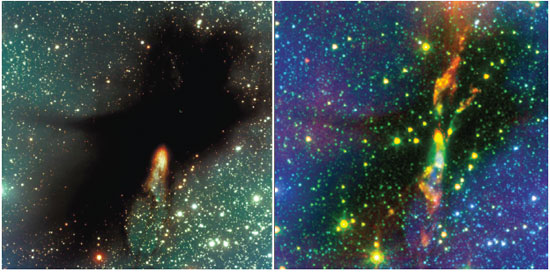
Images courtesy of NASA/JPL-Caltech/T. Bourke [Harvard-Smithsonian CfA] and c2d Legacy Team.
A number of surveys of various types have been executed during Spitzer’s lifetime; some are unbiased looks at regions of the sky that have been extensively studied with other instruments, whereas others are more targeted to certain regions with specific science goals in mind.
The most luminous common stars in the galaxy are called K giants; they are the penultimate phase in the evolution of stars of roughly the same mass as the Sun. K giants produce large amounts of infrared radiation, so much so that Spitzer can detect an individual K giant across the galaxy. In addition, infrared radiation penetrates the dense dust clouds that block our view of the central regions of our galaxy in visible light. Therefore, an infrared survey is the best means of determining the distribution of stars throughout the galaxy.
Spitzer carried out such a survey, imaging large areas in the plane of the galaxy as well as the center, because these are the lines of sight where the density of stars should be highest. Analysis of these data revealed two important facts about the stellar distribution in our galaxy. As had been previously conjectured from other studies, Spitzer dramatically confirmed that our Milky Way galaxy is a barred spiral galaxy, a type not uncommon in our area of the universe. In other words, the arms of the Milky Way do not spiral all the way into the center but originate at the ends of a bar-like distribution of stars that extends about 30 percent of the way from the center of the galaxy to the Sun.
The second fact (not necessarily related to the first) is contrary to previous indications. Our galaxy apparently has only two spiral arms, one leaving each end of the bar, as opposed to the four that previously had been identified based on other measurements. Note that because we live in our galaxy we cannot readily get outside of it to determine what it looks like on a larger scale and how it compares with other galaxies, but the Spitzer insights provide a good start.
Spitzer’s observations of stars have not been limited to K giants. Calculations show that stars with a mass only slightly less than 0.08 times the Sun’s will never become hot and dense enough at their centers for the burning of their nuclear fuel to be self-sustaining. “Stars” in this mass range are called substellar objects or brown dwarfs.
When they are young, brown dwarfs can be observed in the infrared as the heat generated during their gravitational collapse diffuses away. With time, they become successively cooler and fainter. For example, an object of 0.05 solar mass with an age of about 5 billion years, like the Sun, is predicted to have a temperature of less than 1,000 kelvins and a luminosity of only a few millionths that of the Sun. Even a star with 0.1 solar mass of the same age—although a very puny star indeed—would be about three times hotter and more than 100 times more luminous.
The atmospheres of brown dwarfs are expected to be rich in molecules. The chemical equilibrium of the molecular gas, and hence the appearance of the objects’ spectra, will vary systematically as the brown dwarf cools. These variations have been translated into three phases that all brown dwarfs should go through. The youngest objects are referred to as L dwarfs; as they cool, their atmospheric chemistry changes and they evolve into T dwarfs. Finally, the as-yet-undiscovered endpoint of brown dwarf evolution, with temperatures under 500 kelvins, will be occupied by the so-called Y dwarfs.
Brown dwarfs have been of intense interest to astronomers for many reasons. The stars could represent a significant reservoir of mass in the solar neighborhood, and they bridge the gap between stars and planets. The identification of the first brown dwarf in 1995 triggered a flood of discoveries not unlike the one in connection with exoplanets. At present, approximately 1,000 brown dwarfs have been identified, and it appears that brown dwarfs may be about as common locally as all other types of stars combined, but not so common as to constitute much of the total mass of all stars.
Spitzer observations of young stellar clusters show that objects destined to become brown dwarfs are as readily detected as those destined to become low-mass stars, because at this early phase the luminosity from the accretion of matter dominates that of nuclear burning. Intriguingly, many of the brown dwarfs forming in these young clusters show evidence of circumstellar disks within which planets might grow.
A search for “field” brown dwarfs—older, fainter and more uniformly distributed than the young-cluster brown dwarfs—is an important objective of Spitzer’s large-area surveys. Analysis of a recent survey focused on a search for T dwarfs in an area of the sky about 50 times the size of the full Moon. It identified almost 1 million sources, from which a total of about 18 of the coolest types of T dwarfs have been identified.
Because of the extreme faintness of the T dwarfs, even Spitzer could see them only out to about 100 light-years, which confines the search to a very local region. (By comparison, the center of the galaxy is about 25,000 light-years away.) Nonetheless, this is a major increase in the total number of true, cool field T dwarfs known, as most of the others have been discovered as companions to other low-mass stars.
The results also yield an estimate of the abundance of T dwarfs. The upcoming Wide-field Infrared Survey Explorer (WISE), which is scheduled to launch at the end of 2009 and will make an infrared survey of the entire sky, can now be expected to detect perhaps several thousand T dwarfs. WISE is certain to discover the T dwarf closest to the Earth. Either this T dwarf, or perhaps a Y dwarf, could be closer to Earth than even the nearest known star, Proxima Centauri, which lies around 4 light-years distant. Because of the growing evidence that brown dwarfs may host planet-forming disks, this raises the possibility that the nearest exoplanets to Earth may be orbiting not a star, but a brown dwarf.
Because of the expansion of the universe, the radiation from more and more distant objects is increasingly shifted towards the infrared end of the spectrum as it travels toward us. This effect, called the cosmic redshift, makes infrared wavelengths of particular importance for cosmological studies. The radiation from objects at a redshift, or z, of 1, for example, is doubled in wavelength.
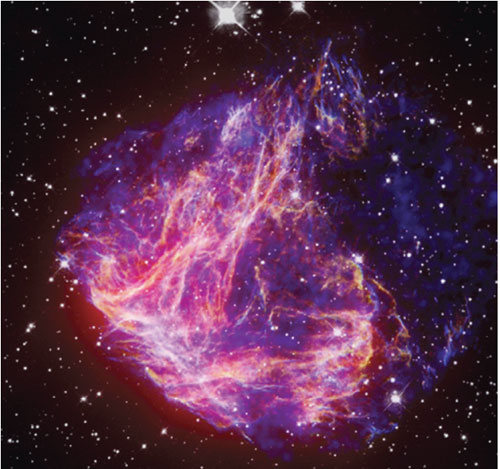
Image courtesy of NASA/CXC/Caltech/S. Kulkarni et al; NASA/STScI/UIUC/Y. H. Chu and R. Williams et al; and NASA/JPL-Caltech/R. Gehrz et al.
The redshift of a distant galaxy is a measure of how far back in space and time the observed light left the object, as well as a measure of the factor by which the universe has expanded since that epoch. Because of the finite speed of light, as we look deeper in space we also look back in time, because it takes longer for the light from a more distant object to reach us. As an illustration, recent measurements indicate the current age of the universe, the time since the Big Bang, is about 13.8 billion years. Galaxies with a z of 1.5 are seen when the universe was about 40 percent of its current size and about 6 billion years old. So those galaxies are literally more than halfway across the universe.
When Spitzer looks back to a z of 6, for example, it is not only looking to an epoch when the universe was 15 percent of its current size; it is also looking back to within about 900 million years of the Big Bang. By observing galaxies both at such great redshifts and also as close as our nearest extragalactic neighbors—the Magellanic Clouds and the Andromeda Nebula—Spitzer has uncovered many of the features of galaxy evolution.
Clusters of galaxies, which can have masses of about a quadrillion (or a million billion) times that of the Sun, are the largest structures in the known universe. The same survey that yielded the brown-dwarf census is producing an equally exciting census of clusters of galaxies in the early universe. Looking at small areas of sky that previously have been observed in other wavelengths, Spitzer’s observations have found a prominent cluster, or gravitationally bound group, of galaxies at a redshift of z=1.4. Spitzer sees these distant clusters quite readily because their optical starlight is shifted into the infrared. The observations have led to the identification of more than 100 clusters of galaxies at redshifts greater than 1 in this one area of sky, many more than had been identified over the entire sky by all previous observations.
The number and properties of high-redshift clusters of galaxies hold clues to the way those structures formed and grew in the early universe. We know from observations of the microwave background radiation still present in the cosmos that the early universe was remarkably smooth and uniform, with minute density and temperature fluctuations superimposed on a uniform background. With time, these fluctuations grew, driven largely by gravitational forces, into the rich variety of structures we see in the universe around us today.
Spitzer’s identification of large numbers of clusters at high redshifts, looking back into space and time, can help us to understand how these and smaller structures developed and evolved. It also could elucidate the roles and perhaps the nature of the mysterious dark matter and dark energy that apparently make up most of the material in the universe.
Studying galaxies at high redshift can also provide clues to their chemical evolution. Spitzer, following up on previous results from IRAS and ISO, has shown that the mid-infrared emission from the interstellar medium in our galaxy and, indeed, from entire galaxies, is dominated by molecules called polycyclic aromatic hydrocarbons (PAHs). These planar hydrocarbon molecules consist of hexagonal carbon rings and their associated hydrogen atoms. PAHs are very familiar on Earth as combustion products; they have been extensively studied by chemists and have also been detected in meteorites.
Despite extensive study over two decades, astronomers still don’t understand the pathways for the formation and evolution of PAHs, or their possible role in bringing organic materials into forming planetary systems. Spitzer has added a new element to this study by measuring galaxies as distant as a redshift of z=2.7 and showing that their PAH emission spectra are virtually identical to those of nearby galaxies. The result suggests that this constituent of the interstellar medium was in place just a few billion years after the Big Bang.
Spitzer can detect galaxies as distant as a redshift of z=7, which means that the light we observe now left the galaxy when the universe was only 12 percent of its present size, and about five percent of its present age. Spitzer’s results indicate that a significant amount of the star formation in the oldest galaxies in the universe took place during an earlier epoch than had been predicted by most models. Controversial but tantalizing Spitzer results suggest extremely massive galaxies may be present at redshifts higher than 6. This result, if confirmed, would represent a major challenge to the theoretical framework of galaxy formation that has been built over the past decade.
With the exhaustion of its liquid helium, Spitzer’s radiative-cooling sytem and its heliocentric orbit—which carries it far from the heat of the Earth—has allowed the telescope and its instruments to remain at a stable temperature below 30 kelvins. Two of Spitzer’s arrays, which cover the shortest wavelength bands at 3.6 and 4.5 micrometers, have the same high sensitivity as before. The Warm Spitzer Mission, using these arrays, will operate for at least two additional years, through mid-2011, with the possibility of an extension for two or three years beyond that before Spitzer drifts out of easy communication range.
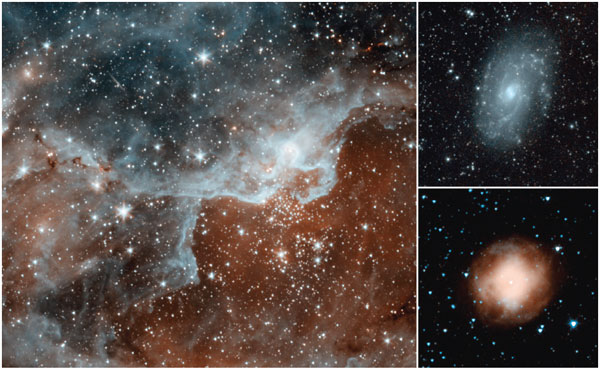
Image courtesy of NASA/JPL-Caltech.
Much of the time available for observations during the first two years of the warm mission has been awarded competitively to scientific teams that will carry out large programs of broad general interest. Some of the topics covered will be familiar: galactic structure, clusters of galaxies and the distant universe. In these areas, Warm Spitzer will extend the results of the cryogenic mission.
In the dynamic area of exoplanet research, Warm Spitzer provides a much-needed capability to follow up on the additional discoveries that will undoubtedly be announced in the coming months, including those from the Kepler Mission, which will employ the first NASA spacecraft devoted to exoplanet studies.
Some totally new programs will also take place, such as monitoring the variability of young and forming stars as a means of studying both the stars and their planet-forming disks, and measurements of hundreds of Near Earth Objects (asteroids and extinct comets) to determine their sizes and to help in the assessment of the hazards these populations might pose to Earth. There will also be a re-examination of the local distance scale to provide an improved value for Hubble’s constant, which relates the recession velocity of a galaxy to its actual distance. In addition to these and other observational advances using Warm Spitzer, the next two years should see a continuing flow of results from Spitzer’s cryogenic mission due to vigorous exploitation of Spitzer’s rich data archive.
Other missions in addition to Warm Spitzer will be supporting the infrared exploration of the universe in the coming years. In May 2009 the European Space Agency and NASA successfully launched the Herschel Space Observatory. Herschel will extend the work of Spitzer to longer wavelengths, looking at cooler and perhaps more distant objects. Its spectrometers will study interstellar atoms and molecules with unprecedented precision. The WISE mission mentioned earlier will launch in late 2009 to carry out a highly sensitive survey of the entire sky at infrared wavelengths. A few years later, the SOFIA airborne observatory will start to carry instruments above most of the Earth’s atmosphere to provide access to much of the infrared spectrum. As an airborne observatory, SOFIA will also support the development and deployment of novel instruments as preludes to their use in space. Finally in the middle of the next decade the James Webb Space Telescope, with 50 times the telescope area of Spitzer, will extend the work of its predecessors to unprecedented depths.
Thus as Spitzer’s rich scientific legacy continues to grow during the coming years, we expect to look back on the depletion of its helium not only with a tinge of sadness but also as the start of an exciting era of new scientific challenges, opportunities and discoveries.
Click "American Scientist" to access home page
American Scientist Comments and Discussion
To discuss our articles or comment on them, please share them and tag American Scientist on social media platforms. Here are links to our profiles on Twitter, Facebook, and LinkedIn.
If we re-share your post, we will moderate comments/discussion following our comments policy.